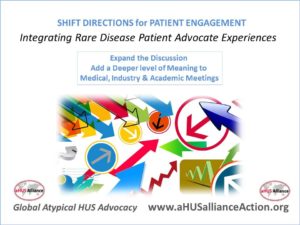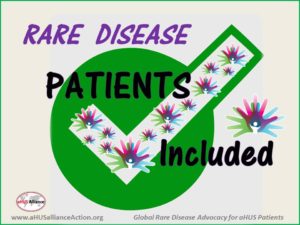
The Last in the aHUS Alliance Four Part Series
Patients Included: Reality or Unmet Goal?
4 MYTHS of Rare Disease Advocacy: Digging deeper into Common Misperceptions
Although there are over 7000 rare diseases, rare patient populations affected by each are by definition very small numbers of people. In nations around the world, people living with a rare disease become advocates to help raise awareness, share information, offer insight, provide support, assist research, and promote healthcare policies that make a positive difference. Depending on the situation, people, and groups involved there’s both an art and a science behind effective advocacy and patient engagement in the rare disease arena. At the same time, proactive avoidance of common pitfalls to may help ideas and projects to bypass ‘echo chambers’ that fail to optimize efforts and maximize results.
The term “rare disease” might mislead the general public as an estimated 350 million people are living with one of these rare diseases, with perhaps many more people still undiagnosed or misdiagnosed. Rare disease statistics, definitions, and other information varies around the world. In Europe, a disease or disorder is defined as rare when it affects fewer than 1 in 2000 people while the USA definition is slightly different, defining a disease or disorder as rare when it affect fewer than 200,000 Americans at any given time. (Source – Rare Disease Day: What is a Rare Disease)
Patients Included: Rare disease patient advocates are invited participants at almost all healthcare and medical conferences.
Despite the many references to “Patients Included” across healthcare and pharmaceutical social media, opportunities for patient advocacy in a variety of forms remains largely a goal – often mentioned but seldom a reality. We applaud those who engage patient advocates and organizations early on, not just for conferences but at all levels of research and programs. Who better to voice the concerns, needs, and challenges of the rare disease community than the patients themselves? “Because patients and caregivers constantly navigate the health care system in search of disease management, they gradually gain an intimate knowledge of the rare condition and are thus in a position to identify when a treatment outcome becomes ‘meaningful’ to them and to subsequently articulate trade-offs.” (Morel T. et al, 2016) Enlisting patients as partners can enrich efforts and add meaning for stakeholders across multiple settings.
There are some signs from corporate and academic circles that rare disease patient advocates are seen as valuable partners with indispensable vantage points available nowhere else. In her PharmaVoice article geared toward an industry audience, Robin Robinson quotes Pfizer VP Dr. Brenda Cooperstone, “We have found that patient advocacy is a distinguishing characteristic of the rare disease space, and because of the complexity and smaller affected populations, it often falls to patients to be involved in everything from clinical trial recruitment to access and reimbursement.” Patient advocacy groups (PAGs) can help shape research agendas, and through partnerships can offer input that proactively assists in building more effective study design, patient recruitment, and programming efforts (Merkel et al, 2016). A sensible initial step for inclusion of broad-ranging ideas and diverse participants would be to create relationships and network with patient organizations and advocates prior to launching such efforts. Creating a rare disease network of value and meaning also can boost rates of involvement, as participation is likely to expand when patient advocates understand the rationale and research benefits to participating and sharing their insights and experiences. In these troubled times, it’s understandable why patient advocates receiving emails from unidentified third parties simply hit ‘Delete’ on cold call email requests to engage, resulting in stunted outreach. It’s become second nature in our society to quickly look for proof of validity or for an authentic connection. Patient advocates wish to be included, but recognize that their involvement rates are higher through personal networks or from a trusted patient advocacy group, as individuals and rare disease groups may have difficulty gauging whether an email contact is from a reputable source or is more likely data-mining or their own for-profit effort. Including rare disease patients in research and meetings provides unique viewpoints, and well worth the proactive planning necessary to engage them as invited and valued participants.
Patients can expand the discussion and add a deeper level of meaning to medical, industry, and academic meetings. The title of this 2017 research from Utengen et al makes a strong case: Patient Participation at Health Care Conferences: Engaged Patients Increase Information Flow, Expand Propagation, and Deepen Engagement in the Conversation of Tweets Compared to Physicians or Researchers. But are patient voices encouraged to join in, how commonly accepted is this practice, and how often does it instead seem that we see mostly “echo chambers” on social media? Who’s adding new content, and who’s building out the discussion in a provocative but responsible and productive way? Patients and advocacy groups can play a key role here. “When I was presenting at medical and technology conferences around the world people used to talk about what the patient wants, or what the doctor wants, without a patient, doctor or nurse being in the room. This astonished me, and a real page turner for me was a conference in Dubai, where all the major telecom companies in the world were present. Everyone was talking about mHealth, how huge it would become, and how many people would be using it, and thereby earning many billions of dollars. When it was my turn to deliver my keynote, I asked the audience ‘How many patients are present here?’. Not one, it appeared.” (Engelen, Reshape at Radboudumc, Patients Included charter)
It’s logical to start with the premise that there are practical barriers that dissuade attempts at patient involvement, in addition to commonly held guides for regulatory or ethical considerations and constraints. This can be particularly challenging on an international stage, where the government policies and regulatory environments differ among the nations involved. Expect this and plan for it, as rare diseases affect people regardless of geographic or cultural boundaries. When patient advocates are invited to participate in medical conferences, connect with industry, or be included in patient advisory panels, there may be language barriers that exist which could be remedied proactively. Often neglected is the strong and basic need for a funding agency liaison to ensure that rare disease advocates are not expected to outlay travel and hotel expenses in addition to their economic disease burden. Prior to engaging individual patient advocates or patient advocacy groups, consider that adult patients may need to address lost work time, have difficulty with travel, or suddenly may experience a personal health crisis that impacts their ability to honor a speaking engagement. Somehow these very practical matters are often forgotten by conference organizers and industry stakeholders who sometimes seem taken aback that rare disease patient advocates are often patients or caregivers. Such individuals are the volunteers that make up the heart and backbone of most rare disease patient nonprofits, but they do not follow at 9 to 5 weekday business schedule and most likely have no assistance or support from any corporate department staff. Patient engagement needs to recognize and build pathways which acknowledge that most rare disease advocates have their employment, family, and health situations as primary concerns. Yes, patients wish to participate as partners – but stakeholders need to provide outreach and opportunities for rare disease advocates that are indicate an understanding of the real life issues, by providing flexibility to overcome such barriers to participation.
Is patient engagement real or more of a myth that’s been relegated to merely buzzwords? How will we know when patient engagement has arrived, and is common practice at healthcare, industry, and other meetings? What simple ‘yardstick’ or complex measurement system can we utilize to know when patient engagement has truly been incorporated, rather than tacked on as an afterthought? As discovered when our aHUS Alliance global action team partnered with physicians for the 2016 Thrombotic Microangiopathy Symposium: Beyond the Lens of aHUS (TMA Boston), Patient Advocate ribbons were still a “special order” item for major suppliers of medical conference event materials. Patient inclusion at healthcare and medical conferences will have “arrived” when major companies promoting medical conference materials routinely include a “Patient Advocate” ribbon as a standard choice alongside “Speaker” and “Doctor” conference badge ribbons selections. Perhaps then we shift the paradigm, moving engagement to a model that fully integrates patient experiences to allow increased benefits from authentic patient voices.
L Burke (Jan 2018)

This is the FOURTH in an aHUS Alliance 4 part series released over four weeks, with its entirety referencing material noted below. Take a closer look at these topics:
Organized groups such as national patient organizations are the only place where individual advocates can make a difference. (Click HERE to read Part 1 of 4 topics)
The best way for rare disease patients to be an advocate is to share their personal journey and patient experiences. (Click HERE to read Part 2 of 4 topics)
Patient populations of any rare disease groups are small, so patient engagement and recruitment needs to follow particular & specific pathways to conduct surveys or to involve patients. (Click HERE to read Part 3 of 4 topics)
Patients Included: Rare disease patient advocates are invited participants at almost all healthcare and medical conferences. (The Article you are Currently Reading)
Resources & Citations
Dharssi S, Wong-Reiger D, Matthew H, and Terry S. Review of 11 national policies for rare diseases in the context of key patient needs
Orphanet J Rare Dis, Mar. 2017.
Morel T et al. Quantifying benefit-risk preferences for new medicines in rare disease patients and caregivers. Orphanet J Rare Dis, May 2016.
Robinson R. Patients and Patient Organizations Power Rare Disease Therapies. PharmaVoice.com FE 2016
Merkel et al. The partnership of patient advocacy groups and clinical investigators in the rare diseases clinical research network. Orphanet Journal of Rare Diseases May 2016
The Origins of Patients Included Patients Included: Charter
Forsythe, L et al. A Systematic Review of Approaches for Engaging Patients for Research on Rare Diseases. J Gen Intern Med. Aug 2014
Potter BK, et al. Translating rare-disease therapies into improved care for patients and families: what are the right outcomes, designs, and engagement approaches in health-systems research? Genet Med. 2016
Editioral, Vivisum Partners: corporate marketing blog Junk In, Junk Out: The Consequences of Poorly Designed Survey Instruments Apr 2014.
Utengen A et al. Patient Participation at Health Care Conferences: Engaged Patients Increase Information Flow, Expand Propagation, and Deepen Engagement in the Conversation of Tweets Compared to Physicians or Researchers. J Med Internet Res, Aug 2017
aHUS Alliance – Assets & Articles (on Topic)
Woodward L et al. An innovative and collaborative partnership between patients with rare disease and industry-supported registries: the Global aHUS Registry. Orphanet Journal of Rare Diseases, Nov 2016. 201611:154
Patients as Partners
2016 aHUS Global Poll, Results: Graphs & Insights
Patient Engagement: A reality or Merely Buzzwords
Thrombotic Microangiopathy Symposium: An Event Partnering Physicians & the aHUS Alliance Patient Organization (TMA Boston, Aug 2017). Patients Included, from Concept Stage through Implementation – An Example of Integration of Patient Experiences with Clinical Expertise, adding an Authentic Patient Voice


